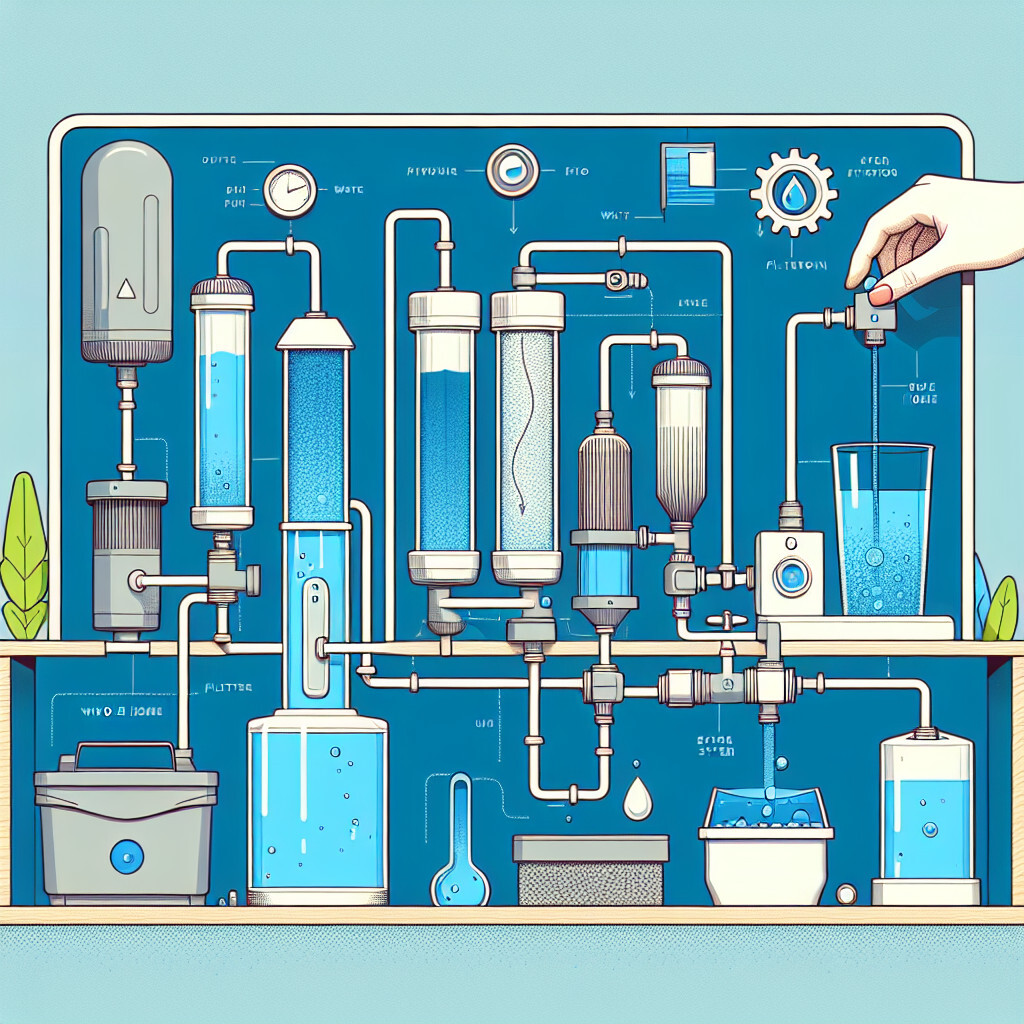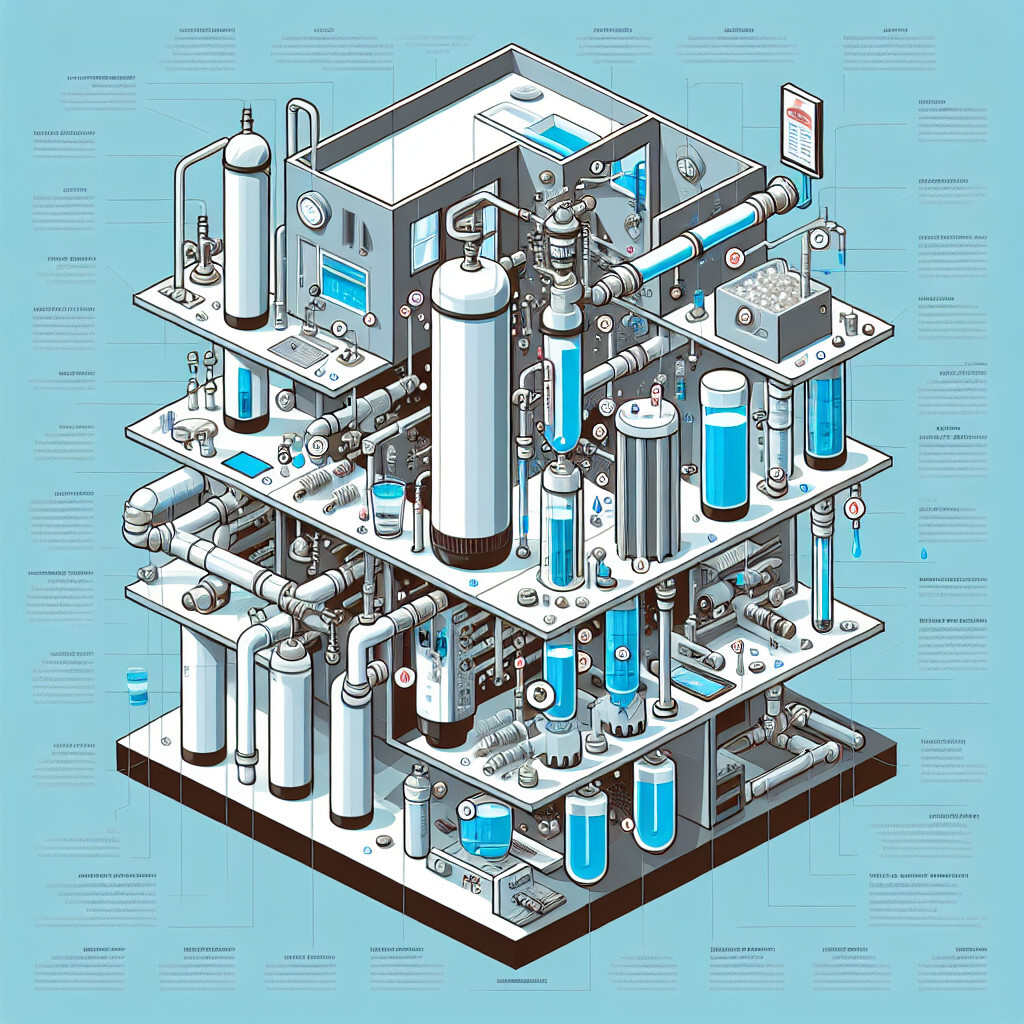-
Table of Contents
- Introduction
- Understanding the Mechanics of Whole Home Water Filtration Systems
- The Science Behind Whole Home Water Filtration: A Detailed Guide
- Exploring the Functionality of Whole Home Water Filtration Systems
- The Process of Purification: How Whole Home Water Filtration Systems Work
- Q&A
- Conclusion
“Whole Home Water Filtration Systems: Purifying Every Drop, Protecting Every Home.”
Introduction

Whole home water filtration systems, also known as point-of-entry systems, are designed to filter all the water that enters a house, providing clean and safe water for drinking, cooking, bathing, and laundry. The system typically works by first pre-filtering the water to remove sediment and large particles. Then, it uses various methods such as activated carbon filters, reverse osmosis, or UV filters to remove contaminants like chlorine, heavy metals, bacteria, and viruses. The result is purified water distributed to all faucets and appliances throughout the home.
Understanding the Mechanics of Whole Home Water Filtration Systems
Whole home water filtration systems, also known as point-of-entry systems, are an increasingly popular choice for homeowners who want to ensure the purity of their water supply. These systems are designed to filter all the water that enters a home, providing clean, safe water for drinking, cooking, bathing, and other uses. But how exactly do these systems work? The mechanics of whole home water filtration systems can be understood by examining their key components and the processes they use to remove contaminants from water.
The first stage in a whole home water filtration system is the pre-filter. This component is responsible for removing larger particles from the water, such as sediment, dirt, and rust. The pre-filter is crucial because it protects the other components of the system from damage and ensures they can function effectively. Without a pre-filter, larger particles could clog the system and reduce its efficiency.
After the pre-filter, the water moves on to the activated carbon filter. This is where the majority of the filtration process takes place. Activated carbon is a highly porous material that can absorb a wide range of contaminants, including chlorine, volatile organic compounds (VOCs), and other chemicals that can affect the taste and smell of water. The activated carbon filter works by trapping these contaminants in its pores, effectively removing them from the water.
In some whole home water filtration systems, there may also be a secondary carbon filter. This serves to further enhance the filtration process, ensuring that even the smallest traces of contaminants are removed. The secondary carbon filter is particularly effective at removing chemicals that are resistant to the primary activated carbon filter.
Next, the water passes through a post-filter. This component is designed to catch any remaining particles that may have slipped through the previous filters. The post-filter ensures that the water leaving the system is as clean and pure as possible.
Finally, the water is treated with a UV purifier or a chemical disinfectant. This step is crucial for killing any bacteria, viruses, or other microorganisms that may be present in the water. UV purifiers work by exposing the water to ultraviolet light, which destroys the DNA of microorganisms and renders them harmless. Chemical disinfectants, on the other hand, kill microorganisms by disrupting their cellular processes.
In conclusion, whole home water filtration systems work by combining several different filtration and disinfection methods. Each component of the system plays a crucial role in removing contaminants and ensuring the purity of the water. The pre-filter removes larger particles, the activated carbon filter and secondary carbon filter absorb chemicals and other contaminants, the post-filter catches any remaining particles, and the UV purifier or chemical disinfectant kills microorganisms. By understanding the mechanics of these systems, homeowners can make informed decisions about the best way to ensure the quality of their water supply.
The Science Behind Whole Home Water Filtration: A Detailed Guide
Whole home water filtration systems, also known as point-of-entry systems, are an increasingly popular choice for homeowners seeking to ensure the purity of their water supply. These systems are designed to filter all the water entering a home, providing clean, safe water for drinking, cooking, bathing, and other household uses. But how exactly do these systems work? The science behind whole home water filtration is both fascinating and complex, involving a series of processes that remove contaminants and improve the quality of water.
The first step in the filtration process is pre-filtration, which is designed to remove larger particles from the water. This is typically achieved using a sediment filter, which traps particles such as sand, silt, and rust. Pre-filtration is crucial as it prevents these particles from clogging the subsequent filters, thereby prolonging their lifespan and ensuring their effectiveness.
Following pre-filtration, the water then passes through an activated carbon filter. Activated carbon is a form of carbon that has been processed to have small, low-volume pores. These pores increase the surface area available for adsorption, a process where certain particles are attracted to activated carbon and stick to it. This filter is particularly effective at removing organic compounds, chlorine, and other chemicals that can affect the taste and odor of water.
In some whole home water filtration systems, the next stage is the addition of a water softener or a descaler. Hard water, which contains high levels of calcium and magnesium, can cause scale buildup in pipes and appliances, reducing their efficiency and lifespan. A water softener replaces these minerals with sodium or potassium ions, while a descaler alters the structure of these minerals to prevent them from adhering to surfaces.
The final stage in many whole home water filtration systems is a post-filter. This filter is designed to catch any remaining particles that may have slipped through the previous stages. It ensures that the water leaving the system is as clean and pure as possible.
However, it’s important to note that not all contaminants can be removed by these processes. For instance, certain microorganisms, heavy metals, and pharmaceuticals require more advanced filtration methods. This is where systems with additional stages, such as reverse osmosis or ultraviolet (UV) disinfection, come into play. Reverse osmosis uses a semi-permeable membrane to remove virtually all contaminants, while UV disinfection kills bacteria and viruses by exposing them to UV light.
In conclusion, whole home water filtration systems work by employing a series of filtration stages, each designed to remove different types of contaminants. From pre-filtration to post-filtration, and sometimes even including advanced methods like reverse osmosis or UV disinfection, these systems ensure that the water entering a home is clean, safe, and of the highest quality. While the science behind these systems may be complex, the result is simple: pure, clean water for every use in your home.
Exploring the Functionality of Whole Home Water Filtration Systems
Whole home water filtration systems, also known as point-of-entry systems, are an increasingly popular choice for homeowners seeking to improve the quality of their water supply. These systems are designed to filter all the water that enters a home, providing clean, safe water for drinking, cooking, bathing, and other uses. But how exactly do these systems work? Let’s delve into the functionality of whole home water filtration systems.
The process begins when water enters the home from a municipal supply or a well. This water often contains various contaminants, such as chlorine, lead, bacteria, and other harmful substances. The water first flows into the whole home water filtration system, which is typically installed at the point where the water supply enters the home.
The filtration process typically involves several stages. The first stage is often a sediment pre-filter, which removes larger particles such as sand, silt, and rust. This not only improves the overall quality of the water but also protects the subsequent filters from damage and premature wear.
Following the pre-filter, the water usually passes through an activated carbon filter. Activated carbon is a highly porous form of carbon that has a large surface area available for adsorption or chemical reactions. It is particularly effective at removing organic compounds, chlorine, and other chemicals that can affect the taste and odor of the water.
In some systems, the water may then pass through a secondary filter designed to remove specific contaminants. For example, a system may include a filter specifically designed to remove lead or a filter that targets volatile organic compounds (VOCs). The type of secondary filter used will depend on the specific contaminants present in the local water supply.
Finally, the water may pass through a post-filter before it is distributed throughout the home. This final filter is designed to catch any remaining particles that may have slipped through the previous filters, ensuring that the water is as clean and pure as possible.
It’s important to note that while whole home water filtration systems are highly effective at removing a wide range of contaminants, they are not designed to remove all types of contaminants. For example, they typically do not remove minerals such as calcium and magnesium, which are responsible for water hardness. If hard water is a concern, a water softener may be needed in addition to the filtration system.
Moreover, whole home water filtration systems require regular maintenance to remain effective. This typically involves replacing the filters at regular intervals, as specified by the manufacturer. Failure to replace the filters as recommended can result in reduced filtration performance and potential damage to the system.
In conclusion, whole home water filtration systems work by passing incoming water through a series of filters designed to remove various contaminants. The result is clean, safe water that is distributed throughout the home for all uses. While these systems require regular maintenance, they offer a highly effective solution for improving the quality of a home’s water supply.
The Process of Purification: How Whole Home Water Filtration Systems Work
Whole home water filtration systems, also known as point-of-entry systems, are an increasingly popular choice for homeowners seeking to ensure the purity of their water supply. These systems are designed to filter all the water entering a home, providing clean, safe water for drinking, cooking, bathing, and other household uses. But how exactly do these systems work? The process of purification in whole home water filtration systems is a fascinating blend of science and technology.
The first step in the purification process begins even before the water reaches your home. Water is typically sourced from either a municipal supply or a private well. In both cases, the water is likely to contain various impurities, including sediment, bacteria, and potentially harmful chemicals. The water’s journey to purification begins when it enters the whole home water filtration system.
The water first passes through a pre-filter, which is designed to remove larger particles such as sand, silt, and sediment. This initial filtration stage is crucial as it prevents these larger particles from clogging the subsequent filters, thereby ensuring the system’s longevity and efficiency.
Following the pre-filter, the water then moves into the activated carbon filter. This filter is the workhorse of the whole home water filtration system. Activated carbon is a form of carbon that has been processed to have small, low-volume pores. These pores increase the surface area available for adsorption, a process where certain particles are attracted to activated carbon and stick to it. This filter effectively removes organic compounds, chlorine, and other chemicals that can affect the taste and odor of the water.
Next, the water may pass through a specialized filter designed to remove specific contaminants. For instance, some systems include a filter for removing lead, while others may have a filter for eliminating specific chemicals or bacteria. The type of specialized filter used depends on the quality of the source water and the specific contaminants it contains.
After passing through these various filters, the water undergoes a final treatment process. This could be ultraviolet (UV) disinfection, which uses UV light to kill bacteria, viruses, and other microorganisms, or it could be a water softener that removes minerals like calcium and magnesium, which can cause scale buildup in pipes and appliances.
Once the water has passed through all these stages, it is distributed throughout the house. Every tap in the home will dispense clean, filtered water, ensuring that every use, from drinking to bathing, is safe and healthy.
In conclusion, whole home water filtration systems work by employing a series of filters and treatment processes to remove impurities and contaminants from the water supply. The result is clean, safe water for all household uses. While the specific processes and filters used may vary depending on the system and the quality of the source water, the goal is always the same: to provide pure, clean water for the entire home.
Q&A
1. Question: What is the basic working principle of whole home water filtration systems?
Answer: Whole home water filtration systems work by forcing incoming water through various types of filters that trap contaminants such as sediment, chlorine, and harmful bacteria. The clean water is then distributed throughout the house.
2. Question: What are the different stages in a whole home water filtration system?
Answer: Typically, a whole home water filtration system includes three stages. The first stage removes larger particles like sand and silt. The second stage uses a carbon filter to remove chlorine and other chemicals. The third stage uses a finer filter to remove remaining smaller particles and bacteria.
3. Question: How often do the filters in a whole home water filtration system need to be replaced?
Answer: The frequency of filter replacement depends on the quality of the incoming water and the usage. However, generally, pre-filters should be replaced every 2-3 months, carbon filters every 6-12 months, and the main filter every 2-5 years.
4. Question: How does a whole home water filtration system improve the quality of water?
Answer: A whole home water filtration system improves water quality by removing harmful contaminants such as chlorine, heavy metals, and bacteria. This results in safer, cleaner, and better-tasting water for drinking, cooking, bathing, and other household uses.
Conclusion
Whole home water filtration systems work by connecting to the main water line entering your home and filtering out harmful contaminants before the water reaches any interior pipes. These systems can remove a variety of pollutants, including chlorine, sediment, iron, and bacteria, providing clean, safe water for drinking, cooking, bathing, and laundry throughout the entire house. The specific filtration process may vary depending on the type of system, but generally involves a pre-filter to remove sediment, a secondary filter to remove smaller contaminants, and a post-filter to catch any remaining particles. Some systems also include a UV purifier to kill bacteria and viruses. Regular maintenance, including filter changes, is required to ensure optimal performance.






